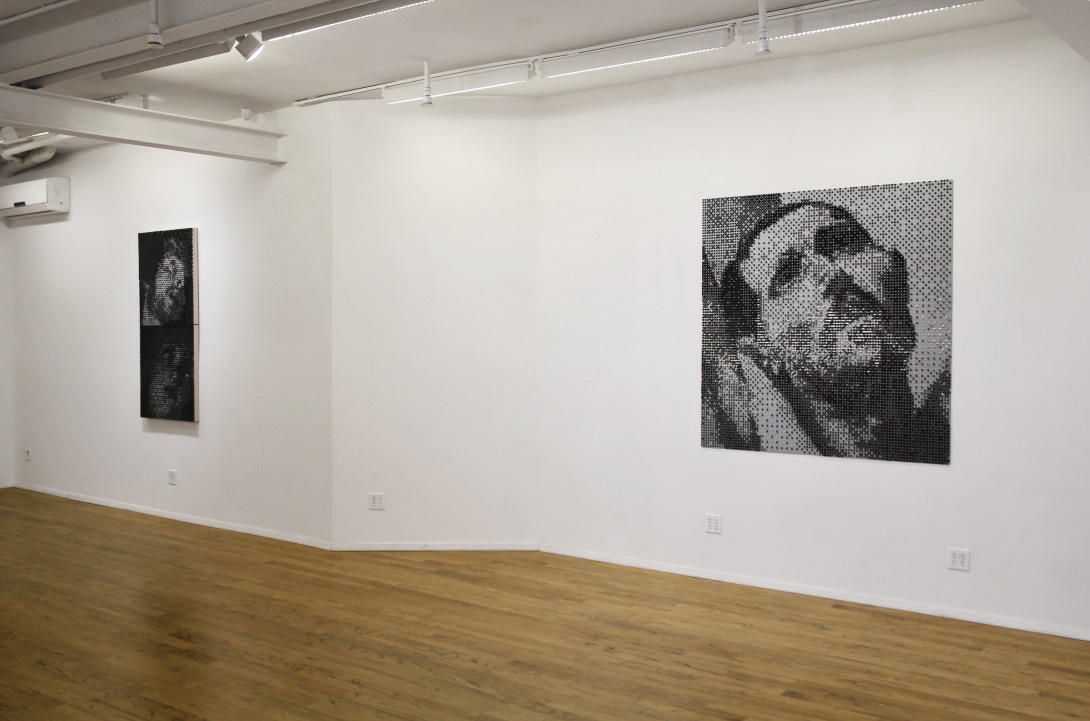





Press Release
Galerie Richard is proud to present Assembly, the gallery’s first solo show with Gustavo Prado. For Assembly, Prado presents recent works from his Ascension and Measure of Dispersion series, two bodies of work that investigate our cultural assumptions and probe questions of perception, the self, and purpose.
Playing on its double meaning, Assembly references Prado’s labor-intensive practices as well as the gathering of religious congregations. Both series employ off-the-shelf materials that Prado activates in unconventional ways, enabling viewers to recognize the source material while deviating from their intended use.
In Measure of Dispersion (2014-ongoing), Prado plays with the spectator’s perception of self within space by manipulating fields of vision and colliding optical planes. Assembled with concave and convex mirrors attached to industrial metal structures, the sculptures create something akin to an anti-camera that scrambles the viewer’s vantage point and exacerbates notions of (dis)location. Rather than capturing a specific, curated moment like a camera shutter, the mirrors reflect a fragmented body seen from uncontrollable angles and different points in space simultaneously.
The resulting viewer experience challenges our impulse to project preconceived assumptions onto what we see: in being confronted with how our reflections exist within our experiences, we are made to test our sense of familiarity with our surroundings and, even more prescient, with ourselves.
Continuing his exploration of human gaze, Prado’s Ascension series (2018-ongoing) renders art historical representations of religious figures into pixelated images crafted in Lego bricks. In contrast to the uncontrollable reflections rendered in his Measure of Dispersion series, Prado articulates these works through a curated collection of repeated events within the history of art: religious figures gazing upward at the heavens, whether in reverence, wonder, or doubt.
In Ascension, Prado focuses on a multitude of religious iconography found through such ordinary means as a Google image search. Prado converts the figures’ upward-gazing faces into bitmapped images, referencing the digital realms that allow us to access historical images with great speed and ease. By then recreating the pixelated faces out of thousands of Legos, Prado assigns symbolic value to these common objects and offers a contrast between the mundane and the spiritual. Prado illustrates that the paradigms through which we interpret our experiences remain rooted in familiar, emotional resonances with the past. In gazing toward the heavens, the religious figures of the past reflect our contemporary desires to understand ourselves within a larger plan.
Assembly as a whole examines how we relate to ourselves within spaces that are activated by various factors, whether through perception, movement, or reference. While Measure of Dispersion shifts our gaze back onto ourselves in order to understand our context, Ascension compels us to look upward toward a symbolic, immaterial reality. By merging these disparate means of actively participating within space, Prado encourages us to forge new pathways whereby we might make sense of our place in the world.
In Ascension, Prado focuses on a multitude of religious iconography found through such ordinary means as a Google image search. Prado converts the figures’ upward-gazing faces into bitmapped images, referencing the digital realms that allow us to access historical images with great speed and ease. By then recreating the pixelated faces out of thousands of Legos, Prado assigns symbolic value to these common objects and offers a contrast between the mundane and the spiritual. Prado illustrates that the paradigms through which we interpret our experiences remain rooted in familiar, emotional resonances with the past. In gazing toward the heavens, the religious figures of the past reflect our contemporary desires to understand ourselves within a larger plan.
Assembly as a whole examines how we relate to ourselves within spaces that are activated by various factors, whether through perception, movement, or reference. While Measure of Dispersion shifts our gaze back onto ourselves in order to understand our context, Ascension compels us to look upward toward a symbolic, immaterial reality. By merging these disparate means of actively participating within space, Prado encourages us to forge new pathways whereby we might make sense of our place in the world.


